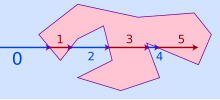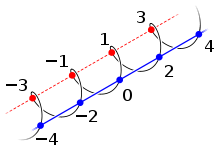Parity of Zero
Zero is an even number. In other words, its parity—the quality of an integer being even or odd—is even. This can be easily verified based on the definition of "even": it is an integer multiple of 2, specifically 0 × 2. As a result, zero shares all the properties that characterize even numbers: for example, 0 is neighbored on both sides by odd numbers, any decimal integer has the same parity as its last digit—so, since 10 is even, 0 will be even, and if y is even then y + x has the same parity as x—and x and 0 + x always have the same parity.
Zero also fits into the patterns formed by other even numbers. The parity rules of arithmetic, such as even − even = even, require 0 to be even. Zero is the additive identity element of the group of even integers, and it is the starting case from which other even natural numbers are recursively defined. Applications of this recursion from graph theory to computational geometry rely on zero being even. Not only is 0 divisible by 2, it is divisible by every power of 2, which is relevant to the binary numeral system used by computers. In this sense, 0 is the "most even" number of all.[1]
Among the general public, the parity of zero can be a source of confusion. In reaction time experiments, most people are slower to identify 0 as even than 2, 4, 6, or 8. Some students of mathematics—and some teachers—think that zero is odd, or both even and odd, or neither. Researchers in mathematics education propose that these misconceptions can become learning opportunities. Studying equalities like 0 × 2 = 0 can address students' doubts about calling 0 a number and using it in arithmetic. Class discussions can lead students to appreciate the basic principles of mathematical reasoning, such as the importance of definitions. Evaluating the parity of this exceptional number is an early example of a pervasive theme in mathematics: the abstraction of a familiar concept to an unfamiliar setting.
Mathematical contexts[edit]
Countless results in number theory invoke the fundamental theorem of arithmetic and the algebraic properties of even numbers, so the above choices have far-reaching consequences. For example, the fact that positive numbers have unique factorizations means that one can determine whether a number has an even or odd number of distinct prime factors. Since 1 is not prime, nor does it have prime factors, it is a product of 0 distinct primes; since 0 is an even number, 1 has an even number of distinct prime factors. This implies that the Möbius function takes the value μ(1) = 1, which is necessary for it to be a multiplicative function and for the Möbius inversion formula to work.[14]
Not being odd[edit]
A number n is odd if there is an integer k such that n = 2k + 1. One way to prove that zero is not odd is by contradiction: if 0 = 2k + 1 then k = −1/2, which is not an integer.[15] Since zero is not odd, if an unknown number is proven to be odd, then it cannot be zero. This apparently trivial observation can provide a convenient and revealing proof explaining why an odd number is nonzero.
A classic result of graph theory states that a graph of odd order (having an odd number of vertices) always has at least one vertex of even degree. (The statement itself requires zero to be even: the empty graph has an even order, and an isolated vertex has an even degree.)[16] In order to prove the statement, it is actually easier to prove a stronger result: any odd-order graph has an odd number of even degree vertices. The appearance of this odd number is explained by a still more general result, known as the handshaking lemma: any graph has an even number of vertices of odd degree.[17]Finally, the even number of odd vertices is naturally explained by the degree sum formula.
Sperner's lemma is a more advanced application of the same strategy. The lemma states that a certain kind of coloring on a triangulation of a simplexhas a subsimplex that contains every color. Rather than directly construct such a subsimplex, it is more convenient to prove that there exists an odd number of such subsimplices through an induction argument.[18] A stronger statement of the lemma then explains why this number is odd: it naturally breaks down as (n + 1) + n when one considers the two possible orientations of a simplex.[19]
Even-odd alternation[edit]
The fact that zero is even, together with the fact that even and odd numbers alternate, is enough to determine the parity of every other natural number. This idea can be formalized into a recursive definition of the set of even natural numbers:
- 0 is even.
- (n + 1) is even if and only if n is not even.
This definition has the conceptual advantage of relying only on the minimal foundations of the natural numbers: the existence of 0 and of successors. As such, it is useful for computer logic systems such as LF and the Isabelle theorem prover.[20] With this definition, the evenness of zero is not a theorem but an axiom. Indeed, "zero is an even number" may be interpreted as one of the Peano axioms, of which the even natural numbers are a model.[21] A similar construction extends the definition of parity to transfinite ordinal numbers: every limit ordinal is even, including zero, and successors of even ordinals are odd.[22]
The classic point in polygon test from computational geometry applies the above ideas. To determine if a point lies within a polygon, one casts a ray from infinity to the point and counts the number of times the ray crosses the edge of polygon. The crossing number is even if and only if the point is outside the polygon. This algorithmworks because if the ray never crosses the polygon, then its crossing number is zero, which is even, and the point is outside. Every time the ray does cross the polygon, the crossing number alternates between even and odd, and the point at its tip alternates between outside and inside.[23]
In graph theory, a bipartite graph is a graph whose vertices are split into two colors, such that neighboring vertices have different colors. If a connected graph has no odd cycles, then a bipartition can be constructed by choosing a base vertex v and coloring every vertex black or white, depending on whether its distance from v is even or odd. Since the distance between v and itself is 0, and 0 is even, the base vertex is colored differently from its neighbors, which lie at a distance of 1.[24]
Algebraic patterns[edit]
In abstract algebra, the even integers form various algebraic structuresthat require the inclusion of zero. The fact that the additive identity (zero) is even, together with the evenness of sums and additive inverses of even numbers and the associativity of addition, means that the even integers form a group. Moreover, the group of even integers under addition is a subgroup of the group of all integers; this is an elementary example of the subgroup concept.[16] The earlier observation that the rule "even − even = even" forces 0 to be even is part of a general pattern: any nonempty subset of an additive group that is closed under subtraction must be a subgroup, and in particular, must contain the identity.[25]
Since the even integers form a subgroup of the integers, they partition the integers into cosets. These cosets may be described as the equivalence classes of the following equivalence relation: x ~ y if (x − y) is even. Here, the evenness of zero is directly manifested as the reflexivity of the binary relation ~.[26] There are only two cosets of this subgroup—the even and odd numbers—so it has index 2.
Analogously, the alternating group is a subgroup of index 2 in the symmetric group on n letters. The elements of the alternating group, called even permutations, are the products of even numbers of transpositions. The identity map, an empty product of no transpositions, is an even permutation since zero is even; it is the identity element of the group.[27]
The rule "even × integer = even" means that the even numbers form an ideal in the ring of integers, and the above equivalence relation can be described as equivalence modulo this ideal. In particular, even integers are exactly those integers k where k ≡ 0 (mod 2). This formulation is useful for investigating integer zeroes of polynomials.[28]
2-adic order[edit]
There is a sense in which some multiples of 2 are "more even" than others. Multiples of 4 are called doubly even, since they can be divided by 2 twice. Not only is zero divisible by 4, zero has the unique property of being divisible by every power of 2, so it surpasses all other numbers in "evenness".[1]
One consequence of this fact appears in the bit-reversed ordering of integer data types used by some computer algorithms, such as the Cooley–Tukeyfast Fourier transform. This ordering has the property that the farther to the left the first 1 occurs in a number's binary expansion, or the more times it is divisible by 2, the sooner it appears. Zero's bit reversal is still zero; it can be divided by 2 any number of times, and its binary expansion does not contain any 1s, so it always comes first.[29]
Although 0 is divisible by 2 more times than any other number, it is not straightforward to quantify exactly how many times that is. For any nonzero integer n, one may define the 2-adic order of n to be the number of times n is divisible by 2. This description does not work for 0; no matter how many times it is divided by 2, it can always be divided by 2 again. Rather, the usual convention is to set the 2-order of 0 to be infinity as a special case.[30] This convention is not peculiar to the 2-order; it is one of the axioms of an additive valuation in higher algebra.[31]
The powers of two—1, 2, 4, 8, ...—form a simple sequence of numbers of increasing 2-order. In the 2-adic numbers, such sequences actually convergeto zero.[32]
https://en.wikipedia.org/wiki/Parity_of_zero





No comments:
Post a Comment